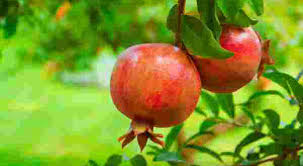Pomegranate farming involves several critical steps to ensure a healthy and productive crop. Here is a comprehensive package of practices for pomegranate cultivation:
1. Site Selection and Soil Preparation
Climate and Soil Requirements:
- Pomegranates thrive in tropical to subtropical climates with temperatures ranging from 25-35°C.
- They are drought-tolerant but perform best with well-distributed rainfall or irrigation.
- Suitable for various soil types, but loamy soils with good drainage and a pH of 5.5 to 7.5 are ideal.
Land Preparation:
- Plow the field to a depth of 30-40 cm to remove weeds and debris.
- Level the field and create raised beds or ridges if necessary to improve drainage.
2. Planting Material and Planting
Variety Selection:
- Choose high-yielding, disease-resistant varieties suitable for your region.
Propagation:
- Pomegranates can be propagated through seeds, cuttings, or air layering.
- Use healthy cuttings about 25-30 cm long from mature, disease-free plants.
Planting:
- Planting time: During the rainy season (June-July) or at the onset of the monsoon.
- Spacing: 4-5 meters between plants and rows.
- Dig pits of 60 x 60 x 60 cm and fill with topsoil mixed with compost or well-decomposed farmyard manure (FYM).
3. Nutrient Management
Fertilization:
- Apply well-decomposed FYM at 20-25 kg per plant annually.
- Basal dose: Apply NPK at 300:200:300 grams per plant annually.
- Apply fertilizers in two splits: one before flowering and the other after fruit set.
- Foliar sprays of micronutrients like zinc and iron can be applied if deficiencies are noticed.
4. Irrigation Management
Watering Schedule:
- Regular irrigation is crucial, especially during flowering and fruit development.
- Frequency: Irrigate every 7-10 days during dry periods.
- Drip irrigation is recommended for efficient water use and to minimize water contact with foliage, reducing disease risk.
5. Weed Management
Weed Control:
- Manual weeding or hoeing around the plants 2-3 times during the growing season.
- Mulching with organic materials like straw or plastic to suppress weeds and conserve moisture.
- Herbicides can be used as per recommendations from local agricultural extensions.
6. Pest and Disease Management
Common Pests:
- Fruit borers, aphids, whiteflies, and mealybugs.
Common Diseases:
- Leaf spot, fruit rot, and bacterial blight.
Control Measures:
- Use disease-free planting material.
- Rotate crops with non-host plants to reduce pest and disease incidence.
- Regularly monitor the field and apply recommended organic or chemical pesticides and fungicides.
- Practice good field sanitation by removing and destroying infected plants.
7. Training and Pruning
Training:
- Train plants to develop a strong framework with a single main stem and 3-5 primary branches.
- Use stakes or trellises if necessary to support young plants.
Pruning:
- Prune plants annually during the dormant season to remove dead, diseased, or weak branches.
- Remove suckers and water sprouts to improve air circulation and light penetration.
8. Flowering and Fruit Development
Flowering:
- Pomegranates produce flowers in three flushes: first (main flowering) in March-April, second (mrig bahar) in June-July, and third (hasta bahar) in September-October.
- Manage water and nutrients to support each flowering flush.
Fruit Development:
- Thinning of excess fruits helps improve the size and quality of remaining fruits.
- Ensure adequate spacing of fruits on the branches to prevent crowding and diseases.
9. Harvesting and Post-Harvest Management
Harvesting:
- Pomegranates are ready for harvest 5-7 months after flowering.
- Harvest fruits when they develop a deep red color and make a metallic sound when tapped.
- Use sharp clippers or knives to cut the fruit with a short stalk.
Post-Harvest Handling:
- Handle fruits carefully to avoid bruising.
- Sort and grade the fruits based on size, color, and quality.
- Wash fruits in clean water to remove dirt and residues.
- Dry the fruits using a clean cloth or air-drying to remove excess moisture.
10. Storage
Storage Conditions:
- Store pomegranates in a cool, dry, and well-ventilated place.
- Ideal storage conditions: 5-10°C and 85-90% relative humidity.
- Use perforated plastic crates or boxes to allow air circulation and prevent spoilage.
11. Marketing
Market Channels:
- Sell fresh pomegranates through local markets, wholesalers, cooperatives, or directly to retailers.
- Explore value addition through processing into products like pomegranate juice, dried arils, or pomegranate powder for higher profitability.
Additional Tips
- Intercropping:
- Consider intercropping with compatible plants like legumes, vegetables, or herbs to optimize land use and increase income.
- Organic Farming:
- If opting for organic farming, avoid synthetic chemicals and use organic manures and bio-fertilizers.
- Record Keeping:
- Maintain detailed records of farming activities, inputs used, and expenses for better management and traceability.
Implementing these practices should help you achieve a successful pomegranate farming venture. For more region-specific advice, consult local agricultural extensions or experts.

